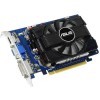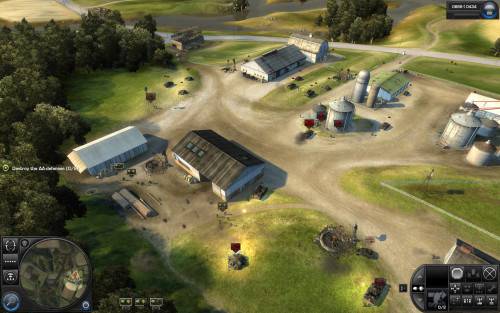- Qualcomm Launches Snapdragon 4 Gen 2 Mobile Platform
- AMD Launches Ryzen PRO 7000 Series Mobile & Desktop Platform
- Intel Launches Sleek Single-Slot Arc Pro A60 Workstation Graphics Card
- NVIDIA Announces Latest Ada Lovelace Additions: GeForce RTX 4060 Ti & RTX 4060
- Maxon Redshift With AMD Radeon GPU Rendering Support Now Available
ASUS GeForce 210, GT 220 & GT 240

This past fall, NVIDIA filled out the remainder of its GT200 series of graphics cards with three models. For basic computing, there’s the $40 GeForce 210, while for those looking to get a bit of light gaming done, there’s the $60 GT 220. And to round things off, there’s the $90 GT 240, which handles all of today’s games rather well at 1080p.
Page 8 – World in Conflict: Soviet Assault
I admit that I’m not a huge fan of RTS titles, but World in Conflict intrigued me from the get go. After all, so many war-based games continue to follow the same story-lines we already know, and WiC was different. It counteracts the fall of the political and economic situation in the Soviet Union in the late 80’s, and instead provides a storyline that follows it as if the USSR had succeeded by proceeding with war in order to remain in power.
Many RTS games, with their advanced AI, tend to favor the CPU in order to deliver smooth gameplay, but WiC favors both the CPU and GPU, and the graphics prove it. Throughout the game’s missions, you’ll see gorgeous vistas and explore areas from deserts and snow-packed lands, to fields and cities. Overall, it’s a real visual treat for the eyes – especially since you’re able to zoom to the ground and see the action up-close.
Manual Run-through: The level we use for testing is the 7th campaign of the game, called Insurgents. Our saved game plants us towards the beginning of the mission with two squads of five, and two snipers. The run consists of bringing our men to action, and hovering the camera around throughout the duration. The entire run lasts between three and four minutes.

The GT 220 continues to flaunt its superiority, while both the GT 210 and Intel’s IGP duke it out nicely, with NVIDIA’s card consistently coming out on top.


The results above are the closest the GT 240 has come to the HD 5670, so much so, that a gamer would never notice the difference between the two.
|
Graphics Card
|
Best Playable
|
Min FPS
|
Avg. FPS
|
|
NVIDIA GTX 295 1792MB (Reference)
|
2560×1600 – Max Detail, 8xAA, 16xAF
|
40
|
55.819
|
|
ATI HD 5870 1GB (Reference)
|
2560×1600 – Max Detail, 4xAA, 16xAF
|
35
|
47.195
|
|
ATI HD 5850 1GB (ASUS)
|
2560×1600 – Max Detail, 4xAA, 16xAF
|
29
|
40.581
|
|
NVIDIA GTX 285 1GB (EVGA)
|
2560×1600 – Max Detail, 0xAA, 16xAF
|
34
|
49.514
|
|
NVIDIA GTX 275 896MB (Reference)
|
2560×1600 – Max Detail, 0xAA, 16xAF
|
36
|
46.186
|
|
NVIDIA GTX 260 896MB (XFX)
|
2560×1600 – Max Detail, 0xAA, 16xAF
|
23
|
39.365
|
|
ATI HD 5770 1GB (Reference)
|
2560×1600 – Max Detail, 0xAA, 16xAF
|
28
|
37.389
|
|
NVIDIA GTX 250 1GB (EVGA)
|
2560×1600 – Max Detail, 0xAA, 4xAF
|
24
|
32.453
|
|
ATI HD 5750 1GB (Sapphire)
|
2560×1600 – Max Detail, 0xAA, 4xAF
|
23
|
31.769
|
|
NVIDIA GT 240 512MB (ASUS)
|
1920×1080 – Max Detail, 0xAA
|
22
|
33.788
|
|
ATI HD 5670 512MB (Reference)
|
1920×1080 – Max Detail, 0xAA, 16xAF
|
21
|
31.872
|
|
NVIDIA GT 220 1GB (ASUS)
|
1280×1024 – Medium Detail, 0xAA
|
41
|
52.089
|
|
NVIDIA 210 512MB (ASUS)
|
1280×1024 – Medium Detail, 0xAA
|
19
|
23.620
|
|
Intel HD Graphics (Clarkdale)
|
1280×1024 – Low Detail, 0xAA
|
30
|
39.449
|
This game might look simple on the surface, but it’s hardcore on graphics. The 210 and GT 220 handled the game fine at 1280×1024, although the 210 was borderline. No one would disagree that 23 FPS is low, but in this particular title, I still deemed it playable enough to warrant the retaining of the settings.
Support our efforts! With ad revenue at an all-time low for written websites, we're relying more than ever on reader support to help us continue putting so much effort into this type of content. You can support us by becoming a Patron, or by using our Amazon shopping affiliate links listed through our articles. Thanks for your support!






